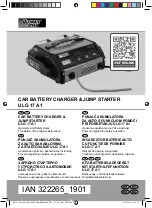
V
FUTABA 9Z
THE UNOFFICIAL WORKSHOP MANUAL
WARNING:
THE INFORMATION IN THIS MANUAL IS FOR INFORMATION PURPOSES ONLY AND MAY BE INCORRECT, CAUSE DAMAGE
TO YOUR RADIO OR INJURY TO YOURSELF AND OTHERS. IF YOU USE THIS MANUAL YOU DO SO SOLEY AT YOUR OWN RISK.
www.jamesandtracy.co.uk
Copyright 2012 jamesandtracy.co.uk
Page 44 of 84
There are a lot of posts about connecting it to the Trainer Port voltage pins, but
personally I’d move it further away from the guts of my transmitter and draw power
straight from the transmitter battery port. Remember your transmitter pack runs at 9.6v
and so you’ll also probably need a voltage regulator to supply the standard 5v inverter.
There are lots of options for a voltage regulator, personally I’d find out the current drawn
by the inverter and use something like the circuit in Figure 40 as it’s small, cheap (~£3)
and easy to create. Another option is to use a standard ESC and connect to the RX wire.
IC1 = 78L05 / 7805 (5v Voltage Regulator)
D1 = 1N4007
C1 = 100uF
C2 = 10uF
Figure 40 Example Voltage Regulator (Check current handling capacity of 78L05)
Once you have your EL Panel, regulator and inverter you can access the LCD like this:
1.
Follow the procedure in Section 3.9 to remove and disassemble the LCD Assembly,
but do not disconnect the short ribbon cable from the LCD. You do not need to
remove the component LCD panel to complete this procedure.
2.
Carefully remove the silver backing foil from the LCD. Do not use a blade as this will
scratch the LCD.
3.
Once the foil is removed use your finger to carefully rub off all the adhesive film that
still remains on the LCD. If this is left in place it will be very visible!
4.
Clean the LCD with a soft cloth
5.
Cut down and attach the EL Panel in place of the silver foil you removed
6.
Reassemble the LCD Assembly being careful to ensure a good contact between
LCD and PCB contacts (Lines will appear on your LCD if a bad contact is made)
7.
Partially reassemble the transmitter, connect the EL Panel and test (see Figure 39).
8.
Locate the position you want to have your backlight switch and fit it (see Figure 39).
9.
Fully reassemble the transmitter.
4.5. 9Z Mode and Version Change (e.g. ZAP to ZHP)
Note: I have not personally tested this procedure and, considering the damage that
could be done if an error was made, I would attempt it lightly.
The 9Z can have its stick mode and default version (helicopter or aircraft) changed
through the modification of a resistor on the main PCB (see Figure 41). However, an
















































